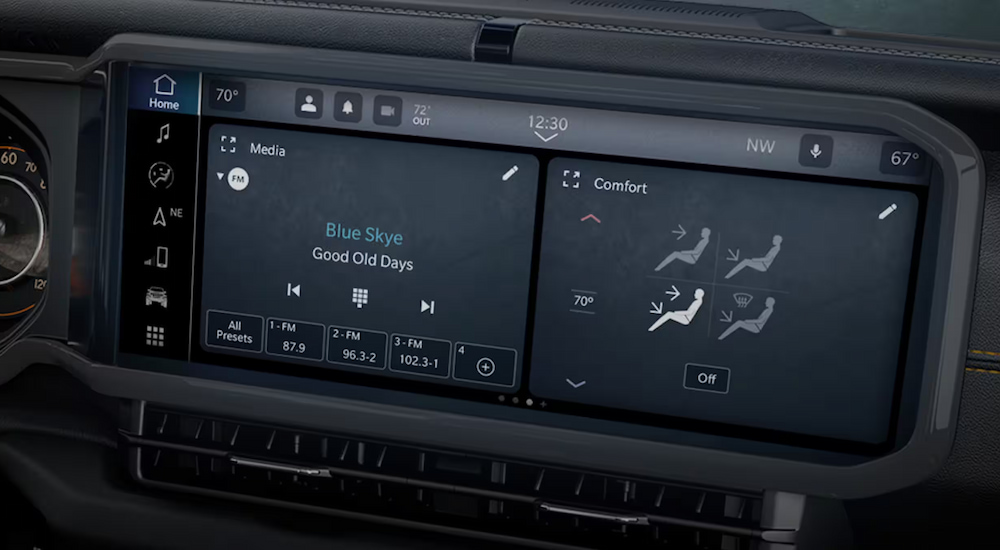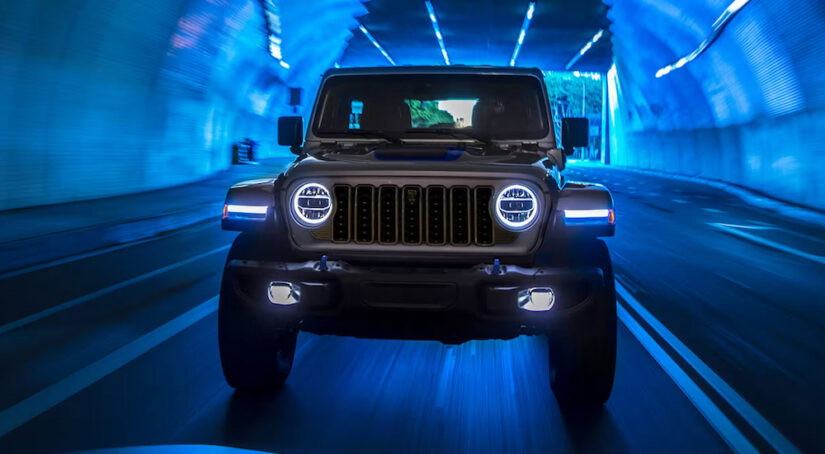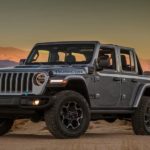When most drivers think of hybrids, they tend to imagine cars like the Toyota Prius, Honda Insight, and Chevy Volt––compact commuter models designed to save fuel above all else. In recent years, this has been changing, as hybrid technology has taken over segments ranging from supercars like the Corvette E-Ray to off-road machines like the Jeep Wrangler 4xe. These models take advantage of the raw power offered by electric motors to post record-breaking quarter-mile times and take off-road performance to new heights. But are these new hybrid options actually that efficient, or have they abandoned fuel economy altogether in pursuit of greater performance? If you are thinking about finding a Jeep Wrangler 4xe for sale, how much gasoline will it actually save you?
The Wrangler 4xe Is an Unconventional Success
When it comes to this new generation of unconventional performance-first hybrid models, the poster child is undoubtedly the Wrangler 4xe. Traditionally, the brick-shaped Wrangler is about as far from being fuel-efficient as possible, so it was certainly surprising when Jeep decided to make it the first hybrid in the brand’s lineup. However, despite the Wrangler’s reputation as a gas-guzzling throwback to a simpler time, the Wrangler 4xe has been wildly successful. In fact, Jeep has managed to sell nearly 20,000 of the plug-in hybrid in the first quarter of 2024 alone! That’s nearly half of all Wrangler sales and makes the Wrangler 4xe hands-down the best-selling plug-in hybrid on the market.
Setting aside the hybrid aspect of the vehicle for a moment and simply looking at the specs, the popularity of the Wrangler 4xe becomes a little less surprising. By combining two electric motors with a 2.0L turbocharged gasoline engine, Jeep has produced an off-road vehicle that offers 375 hp and 470 lb-ft of torque. That’s enough power to launch from zero to 60 mph in just over five seconds! To give some perspective, that is faster than the Ford Bronco Raptor with its $90,000 price tag. Who wouldn’t want that sort of power from their Wrangler? It even makes the model’s $50,000 starting price look like a downright bargain.
But What About Efficiency?
Turning to the question of efficiency is where things get murky. The Wrangler 4xe is a plug-in hybrid, and the EPA doesn’t do a very good job of measuring plug-in hybrid efficiency with its official fuel economy estimates. If you head to your local Jeep dealership to take a look at the Monroney stickers in the windows, you’ll see a nice big 49 MPGe for the Wrangler 4xe compared to just 20 MPG for the base-model gasoline-powered Wrangler. Seems rather clear-cut, doesn’t it? The Wrangler 4xe is almost two and a half times more efficient, right? Well, not really.
Plug-in hybrid models effectively have two separate powertrains––the electric motors and the gasoline engine. Like most models, the Wrangler 4xe gives drivers the option to manually select which powertrain they want to use or if they want to combine both of them with three available driving modes (Electric Mode, eSave Mode, and Hybrid Mode). Because of these options, there isn’t really a way to give a single definitive number for efficiency. Instead, the EPA gives two ratings. There is a traditional MPG rating for the gasoline powertrain and an MPGe rating for the electric powertrain.
In the case of the 2024 Jeep Wrangler 4xe, that big 49 on the Monroney sticker refers to MPGe, which is how efficient the electric motors are if you measure the electricity they consume in terms of how much energy is in a gallon of gasoline. Once the battery is depleted and you are relying on the gasoline engine, then the 2024 Wrangler 4xe is only rated for 20 MPG combined––exactly the same as a Wrangler with the gasoline V6. This means that the efficiency of the plug-in hybrid largely depends on how often you plug it in.

The Plug-In Lifestyle
Unlike a battery-electric vehicle, a major selling point of a plug-in hybrid is that plugging it in is entirely optional. There is absolutely nothing preventing you from buying a Wrangler 4xe and simply driving it like a traditional hybrid without ever plugging it in. In fact, by using eSave mode to let the car recharge itself, you can even benefit from fully electric zero-emissions driving without plugging in to recharge. If driven in this manner, the Wrangler 4xe is no more efficient than any other Wrangler, although it is still significantly more powerful.
However, if you are interested in the plug-in lifestyle, then the Wrangler 4xe can be remarkably efficient. Depending on your driving habits and how often you plug in to recharge, it is possible to spend nearly all of your time on the road in electric mode. The key here is making sure that your average distance between charging is less than the Wrangler 4xe’s estimated all-electric range of 22 miles. Now, if you work from home and mainly use your car to run short errands around town, then this is easy to achieve. Simply plug in at home, and your weekly trips to the gas station will become a relic of the past. However, if you commute to work, then things get more difficult.
Maximizing Charging
If you have a commute of 10 miles or less, then the Wrangler 4xe has enough electric range to get by with home charging. Unfortunately, the average commute is over 27 miles, which means you will deplete the battery before you get to work and will be relying entirely on the gasoline engine to get you home unless you can recharge at your workplace. Now, you might be wondering, why not just use a public charging station to top off the battery? Well, charging speed isn’t a major selling point of plug-in hybrid models, and the Wrangler 4xe is no exception.
The Wrangler 4xe is only compatible with Level 1 and Level 2 charging, not Level 3 DC fast charging. Further, it will only accept 32 amps from Level 2 charging, rather than the 48 amps you will get with many fully electric models. This means that while its 17 kWh battery is less than a quarter the size of an EV like the Tesla Model 3, the Wrangler 4xe takes roughly 2.5 hours to fully charge––and the short electric range means you would likely want a full charge if you are thinking about using a public charger. Needless to say, that sort of charging time means using public charging stations is not particularly convenient.
With the Wrangler 4xe, virtually all charging will be done at home or work if you are lucky enough to have charging there. Public charging should mostly be considered a bonus if you can plug in at a shopping mall or other destination while out and about rather than something you will use regularly to get more electric range. In short, being able to rely on the Wrangler 4xe’s battery to reduce gasoline consumption significantly is almost entirely dependent on the length of your commute and whether you can recharge at work as well as at home.
![]()
Gas Savings Depend on You
The Wrangler 4xe is an incredible piece of engineering that has taken the plug-in hybrid market by storm, easily exceeding sales of more conventional models like the Toyota Prius Prime and Ford Escape PHEV. With electrified power and the iconic design and capabilities of the Wrangler, it’s no surprise that drivers have flocked to it, but efficiency will depend on your driving and charging habits. When operated as a traditional hybrid, the Wrangler 4xe is no more efficient than a normal V6 Wrangler, and making the most of its electric range requires either an extremely short commute or access to charging at work. While making sure to recharge every time you get home can meaningfully reduce your gasoline consumption even if you have a longer commute, most drivers will find they are spending far more time with the gasoline engine running than in electric mode. Still, what other plug-in hybrid gives you the opportunity to take the roof and doors off to enjoy the great outdoors while out-accelerating some sports cars?


